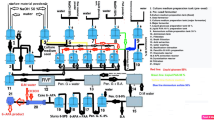Abstract
Penicillin G (Pen-G) was hydrolyzed to 6-aminopenicillanic acid (6-APA) and phenylacetic acid (PAA) in a chromatographic reactor-separator using the mixture of immobilized Escherichia coli cells and a macroporous adsorbent as stationary phase and a phosphate buffer of pH 7.8 as eluant. Pen-G conversion of 98% was observed without adjustment of the eluant pH due to the effective separation of 6-APA from Pen-G and PAA. At a sample load of 600 mg Pen-G, the volume overload gave higher Pen-G conversion (86%) than the mass overload (68%), while their difference in product resolution (0.9 and 1.0, respectively) was insignificant.
Similar content being viewed by others
References
Andersson E, Mattiasson B, Hahn-Hagerdal B (1984) Enzymatic conversion in aqueous two-phase system: deacylation of benzylpenicillin to 6-aminopenicillanic acid with penicillin acylase. Enzyme Microbiol. Technol 6: 301–306.
Balasingham K, Warburton D, Dunnill P, Lilly MD (1972) The isolation and kinetics of penicillin amidase from Escherichia coli. Biochim. Biophys. Acta 276: 250–256.
Cretier G, Rocca JL (1985) Mass overload in preparative liquid chromatography: band broadening and maximum sample load. Chromatographia 20: 461–464.
Duan G, Chen JY (1996) Kinetic analysis of the effects of products removal on the hydrolysis of penicillin G by immobilized penicillin acylase. Process Biochem. 31: 27–30.
Ishimura F, Suga KI (1992) Hydrolysis of penicillin G by combination of immobilized penicillin acylase and electrodialysis. Biotechnol. Bioeng. 39: 171–175.
Ospina SS, Barzana E, Ramirez OT, Lopez-Munguia A (1996) Effect of pH in the synthesis of ampicillin by penicillin acylase. Enzyme Microbiol. Technol 19: 462–469.
Ospina SS, Lopez-Munguia A, Gonzalez RL, Quintero R (1992) Characterization and use of a penicillin acylase biocatalyst. J. Chem. Tech. Biotechnol. 53: 205–214.
Wu JC, He ZM, Yu KT (1996) Study on process of simultaneous biochemical reaction and chromatographic separation. J. Chem. Ind. Eng. China 47: 192–196.
Zafar I, Barker PE (1988) An experimental and computational study of a biochemical polymerization reaction in a chromatographic reactor-separator. Chem. Eng. Sci. 43: 2369–2375.
Author information
Authors and Affiliations
Rights and permissions
About this article
Cite this article
Wu, J., He, Z., Han, Z. et al. Enhancement of penicillin G hydrolysis using penicillin acylase to 6-aminopenicillanic acid by simultaneous chromatographic separation. Biotechnology Letters 22, 1959–1962 (2000). https://doi.org/10.1023/A:1026706111815
Issue Date:
DOI: https://doi.org/10.1023/A:1026706111815




